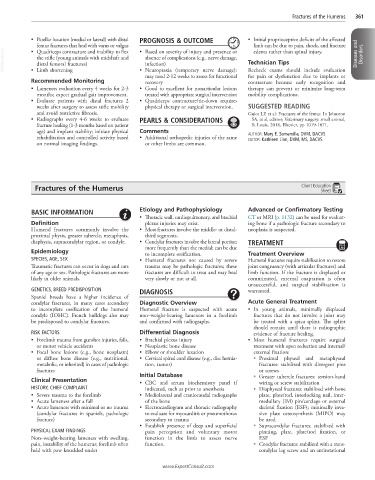Page 765 - Cote clinical veterinary advisor dogs and cats 4th
P. 765
Fractures of the Humerus 361
• Patellar luxation (medial or lateral) with distal PROGNOSIS & OUTCOME • Initial proprioceptive deficits of the affected
femur fractures that heal with varus or valgus • Based on severity of injury and presence or limb can be due to pain, shock, and fracture
VetBooks.ir the stifle (young animals with midshaft and absence of complications (e.g., nerve damage, Technician Tips Diseases and Disorders
edema rather than spinal injury.
• Quadriceps contracture and inability to flex
distal femoral fractures)
infection)
• Limb shortening
• Neuropraxia (temporary nerve damage):
for pain or dysfunction due to implants or
may need 2-12 weeks to assess for functional Recheck exams should include evaluation
Recommended Monitoring recovery contracture because early recognition and
• Lameness evaluation every 4 weeks for 2-3 • Good to excellent for nonarticular lesions therapy can prevent or minimize long-term
months; expect gradual gait improvement. treated with appropriate surgical intervention mobility complications.
• Evaluate patients with distal fractures 2 • Quadriceps contracture/tie-down requires
weeks after surgery to assess stifle mobility physical therapy or surgical intervention. SUGGESTED READING
and avoid restrictive fibrosis. Guiot LP, et al: Fractures of the femur. In Johnston
• Radiographs every 4-6 weeks to evaluate PEARLS & CONSIDERATIONS SA, et al, editors; Veterinary surgery: small animal,
fracture healing (1-3 months based on patient St Louis, 2018, Elsevier, pp 1019-1071.
age) and implant stability; initiate physical Comments AUTHOR: Mary E. Somerville, DVM, DACVS
rehabilitation and controlled activity based • Additional orthopedic injuries of the same EDITOR: Kathleen Linn, DVM, MS, DACVS
on normal imaging findings. or other limbs are common.
Fractures of the Humerus Client Education
Sheet
BASIC INFORMATION Etiology and Pathophysiology Advanced or Confirmatory Testing
• Thoracic wall, cardiopulmonary, and brachial CT or MRI (p. 1132) can be used for evaluat-
Definition plexus injuries may exist. ing bone if a pathologic fracture secondary to
Humeral fractures commonly involve the • Most fractures involve the middle- or distal- neoplasia is suspected.
proximal physis, greater tubercle, metaphysis, third segments.
diaphysis, supracondylar region, or condyle. • Condylar fractures involve the lateral portion TREATMENT
more frequently than the medial; can be due
Epidemiology to incomplete ossification. Treatment Overview
SPECIES, AGE, SEX • Humeral fractures not caused by severe Humeral fractures require stabilization to restore
Traumatic fractures can occur in dogs and cats trauma may be pathologic fractures; these joint congruency (with articular fractures) and
of any age or sex. Pathologic fractures are more fractures are difficult to treat and may heal limb function. If the fracture is displaced or
likely in older animals. very slowly or not at all. comminuted, external coaptation is often
unsuccessful, and surgical stabilization is
GENETICS, BREED PREDISPOSITION DIAGNOSIS warranted.
Spaniel breeds have a higher incidence of
condylar fractures, in many cases secondary Diagnostic Overview Acute General Treatment
to incomplete ossification of the humeral Humeral fracture is suspected with acute • In young animals, minimally displaced
condyle (IOHC). French bulldogs also may non–weight-bearing lameness in a forelimb fractures that do not involve a joint may
be predisposed to condylar fractures. and confirmed with radiographs. be treated with a spica splint. The splint
should remain until there is radiographic
RISK FACTORS Differential Diagnosis evidence of fracture healing.
• Forelimb trauma from gunshot injuries, falls, • Brachial plexus injury • Most humeral fractures require surgical
or motor vehicle accidents • Neoplastic bone disease treatment with open reduction and internal/
• Focal bone lesions (e.g., bone neoplasm) • Elbow or shoulder luxation external fixation:
or diffuse bone disease (e.g., nutritional, • Cervical spinal cord disease (e.g., disc hernia- ○ Proximal physeal and metaphyseal
metabolic, or inherited) in cases of pathologic tion, tumor) fractures: stabilized with divergent pins
fractures or screws
Initial Database ○ Greater tubercle fractures: tension-band
Clinical Presentation • CBC and serum biochemistry panel if wiring or screw stabilization
HISTORY, CHIEF COMPLAINT indicated, such as prior to anesthesia ○ Diaphyseal fractures: stabilized with bone
• Severe trauma to the forelimb • Mediolateral and craniocaudal radiographs plate, plate/rod, interlocking nail, inter-
• Acute lameness after a fall of the bone medullary (IM) pin/cerclage or external
• Acute lameness with minimal or no trauma • Electrocardiogram and thoracic radiography skeletal fixation (ESF); minimally inva-
(condylar fractures in spaniels, pathologic to evaluate for myocarditis or pneumothorax sive plate osteosynthesis (MIPO) may
fracture) secondary to trauma be used.
• Establish presence of deep and superficial ○ Supracondylar fractures: stabilized with
PHYSICAL EXAM FINDINGS pain perception and voluntary motor pinning, plate, plate/rod fixation, or
Non–weight-bearing lameness with swelling, function in the limb to assess nerve ESF
pain, instability of the humerus; forelimb often function. ○ Condylar fractures: stabilized with a trans-
held with paw knuckled under condylar lag screw and an antirotational
www.ExpertConsult.com

